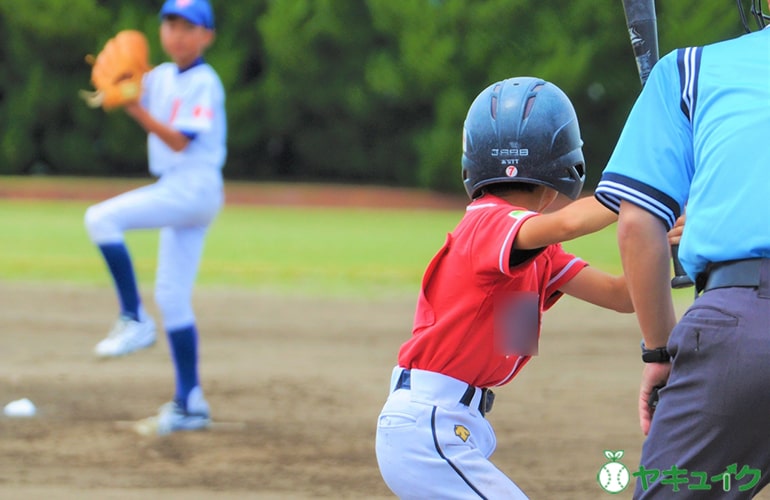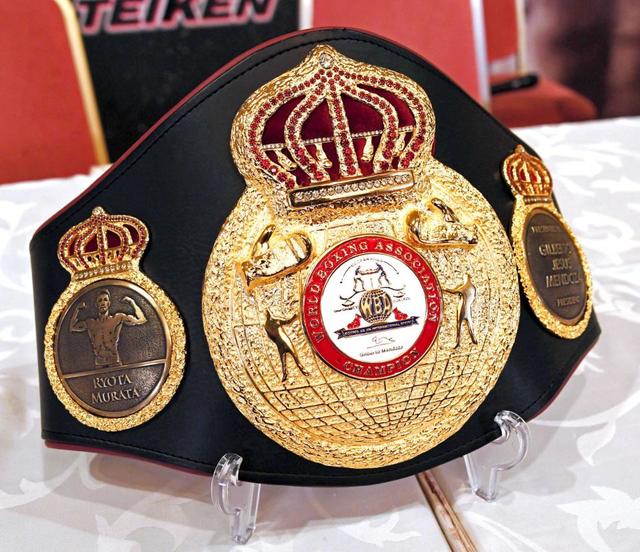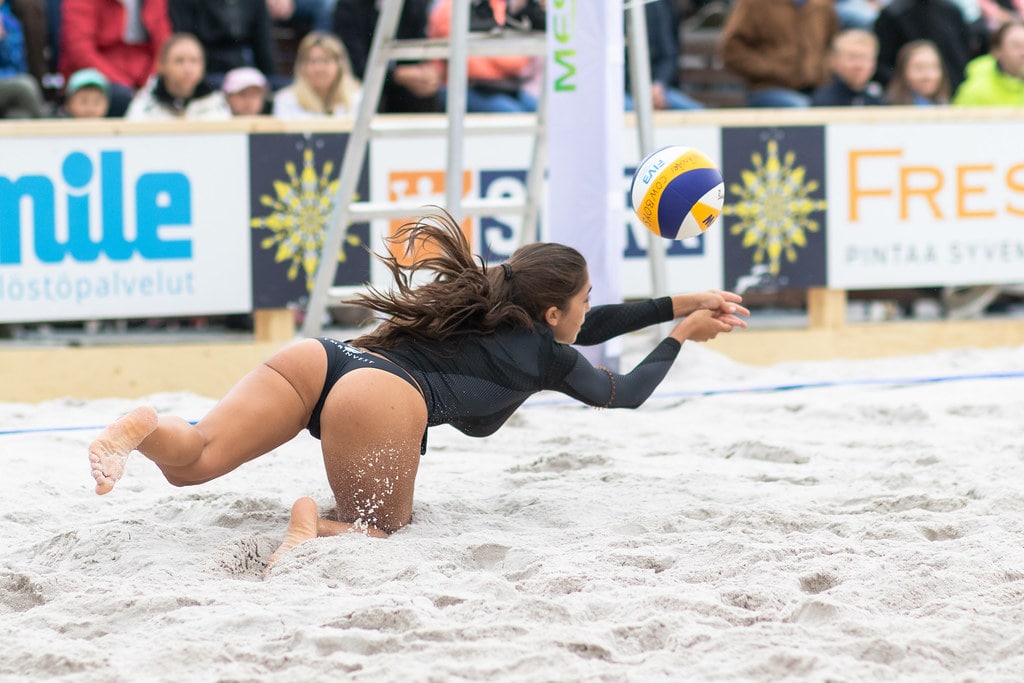
Beach volleyball is a dynamic sport played on the sand and is loved by many people around the world.
However, beach volleyball is different from indoor volleyball, and has its own unique environment and rules.
Therefore, it is important for everyone from beginners who have just started playing beach volleyball to intermediate players looking to further improve their skills to know how to practice effectively.
This article covers a wide range of topics, starting with an introduction to the basic rules and equipment of beach volleyball, learning basic techniques, conditioning, the basics of strategic play, and even strengthening mental training and teamwork. I will explain in detail how to practice volleyball.
Use this information as a guide to get the most out of beach volleyball and take your skills to the next level.
目次
Introduction to beach volleyball: Start with the basics
Beach volleyball is an exhilarating sport that can be enjoyed under the sun and on the sand.
In this section, we will explain the basic knowledge you need to know to start playing beach volleyball, the necessary equipment, and how to move effectively on the sand.
Basic knowledge of beach volleyball
Beach volleyball is mainly played 2 on 2. The court will be 16 meters long and 8 meters wide, with a net in the center measuring 2.43 meters (men) or 2.24 meters (women) high.
The objective is to hit the ball into the opponent’s court so that the opposing team cannot return it.
Each team must play the ball with a maximum of three touches (including the receiver of the serve) and send it back to the opponent’s court.
Necessary equipment
- Ball: Provide an official-sized beach volleyball suitable for outdoor use. Beach volleyballs are slightly larger and softer than indoor volleyballs.
- Appropriate clothing: Choose appropriate clothing for sand and sun. Sunglasses, a hat, and sunscreen are also important. Sportswear and swimsuits that are easy to move in are preferred.
- Hydration: Hydration is very important as this is an outdoor sport. Bring plenty of water or sports drinks.
How to move on the sand
- How to use your feet: It ‘s difficult to balance on the sand, so it’s a good idea to spread your feet apart for more stability. Move quickly with small steps to avoid getting caught in the sand.
- Jump tricks: Jumping on sand requires more force than jumping on hard ground. The key is to bend your knees deeply and use the entire sole of your foot to kick strongly.
- Maintaining form: Even on unstable sand, it’s important to maintain proper form. In particular, when hitting or receiving the ball, be sure to keep your body balanced and move accurately.
Beach volleyball is a sport that requires not only skill but also the ability to adapt to the unique sand environment.
By equipping yourself with basic knowledge and equipment, and mastering how to move effectively on the sand, you can maximize the fun of beach volleyball.
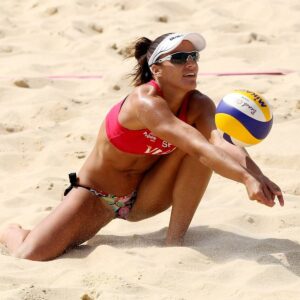
Acquire basic skills: serve, receive, spike
To improve your beach volleyball skills, it is essential to master the three basic skills of serving, receiving, and spiking.
These techniques greatly influence the flow of the game and can even determine the outcome of the match.
Here we will explain the basic forms required for each skill and effective practice methods.
serve
The serve is the first action to start the game. A powerful and accurate serve puts pressure on the opposing team.
- Basic form: Hold the ball in your serving hand and hit the ball with your other hand. At the moment of hitting the ball, keep your arms extended and apply force to the ball from diagonally above.
- How to practice: In order to improve the accuracy of your serve, it is effective to set a target and practice. Target your serves to specific areas of the court to improve your consistency and accuracy.
receive
Receive is the skill of receiving an opponent’s serve or attack. Good receiving gives the team the right to attack.
- Basic form: Stand low with your feet shoulder-width apart and your knees bent. Extend your arms and place your hands together to control the ball in front of your body.
- How to practice: Practice tossing and receiving with a partner. Train your receiving reaction speed and accuracy by having the ball come at you at different heights and speeds.
spike
Spiking is a powerful attacking technique that creates scoring opportunities. Jump high and hit the ball down with force.
- Basic form: Shift from approach (running) to jump, raise your hitting arm and hit the ball hard. When hitting the ball, it is effective to use the snap of your wrist to add spin.
- How to practice: In order to master the timing and force control of spikes, it is effective to practice hitting against a wall or using a net. Plyometric training to increase jumping power is also important.
These basic skills are important components of beach volleyball play.
By understanding the form required for each skill and honing your technique through repeated practice, you can improve your ability as a beach volleyball player.
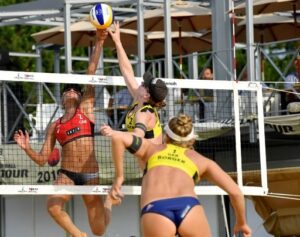
Conditioning and physical fitness
Beach volleyball mainly involves movements on the sand, so it requires a unique level of physical strength and muscular strength.
Here we will introduce training methods for conditioning and building physical strength specifically for beach volleyball.
These trainings are aimed at improving your balance and endurance on the sand.
training on the sand
- Barefoot Running: Running barefoot on the sand strengthens the muscles in your feet and increases sensation in the soles of your feet. The resistance of the sand puts a higher strain on you than regular running, which also improves your cardiovascular fitness.
- Sand Squats: Squats on sand are more difficult to balance than regular squats. This improves core muscles and lower body stability.
strength training
- Plyometric training: Also known as jump training, plyometric training improves explosive power and speed. It is effective for training the high jumping power required for beach volleyball.
- Core Training: Core muscles are the foundation of every movement in beach volleyball. Incorporate core-strengthening exercises like planks, crunches, and Russian twists.
endurance training
- Interval training: Running short distances at high intensity, followed by short periods of rest. This training is similar to the short rally and rest cycles in beach volleyball, and is effective for building endurance during matches.
- Circuit training: Circuit training, which involves performing multiple exercises in sequence, can improve overall body strength and endurance at the same time.
Conditioning and building physical strength for beach volleyball requires a comprehensive approach.
By combining strength training, endurance training, and specialized training on the sand, you can maximize your beach volleyball performance.
Continuous training will improve your movements in matches and help you achieve better results.

Fundamentals of strategic play
In beach volleyball, not only technical ability but also strategic thinking is very important.
By honing your ability to read your opponent’s movements, effective positioning, and the fundamentals of team play, you can gain an advantage in the match.
Here we will introduce a practice method that focuses on the strategic aspects of beach volleyball.
read your opponent’s movements
- Video analysis: Analyze the opponent team’s game footage to understand their trends and habits. It provides clues to predict the direction of serve and attack patterns in specific situations.
- Practice matches: Practice reading your opponent’s movements in real time through practice matches. Predict the next play based on your opponent’s approach and hand movements, and practice appropriate responses.
effective positioning
- Court Coverage Practice: Improve coordination with your partner and practice positioning to maximize court coverage. Let’s practice using signs and communication to learn when to split into front and back and left and right.
- Defensive Positions: Predict areas that are likely to be attacked and practice optimal defensive positions. Find a position where you can cover effectively based on your opponent’s attack tendencies.
Basics of team play
- Communication: Strengthening communication with partners is the key to effective team play. Establish communication methods, such as how to use signs and calling out during play.
- Division of roles: It is important to clearly define the division of roles within the team and for each person to play their own role. Consider the balance between attack and defense, and be able to flexibly change your role depending on your opponent’s strategy.
In order to play strategic beach volleyball, it is essential to be aware of these points and gain experience through practice and actual play.
By reading your opponent’s movements, improving your positioning, and optimizing your team play, you can increase your success rate in matches.
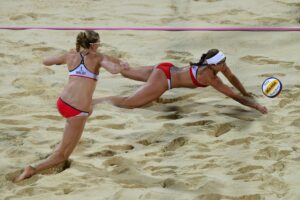
Practice methods to improve
Efficient and practical practice is essential to improving your beach volleyball skills.
Aim to improve your skills in all aspects by incorporating a wide range of drills, from individual practice to pair practice.
Here we will introduce practice methods that will help you improve your beach volleyball skills.
individual practice drills
- Serve practice: Practice hitting the serve from the edge of the court to the desired location. Increase your accuracy and power by changing the types of serves (floater serve, jump serve, etc.).
- Practice hitting against a wall: Practicing against a wall is a good way to hone your passing and set techniques. Aim for precise control by hitting the ball back against the wall with a certain rhythm.
pair practice drills
- Serve-receive practice in pairs: Take turns serving and receiving with a partner to train reaction speed and accuracy in a manner similar to real combat. Increase your ability to respond by changing the direction and strength of your serve.
- Spiking and blocking practice: One person will be the spiker and the other will be the blocker and practice offensive and defensive movements. Attackers try to spike from various angles, while defenders adjust the timing and positioning of their blocks.
Comprehensive gameplay practice
- Scrimmage (mock match): Hold a scrimmage that simulates a real battle and practice in a game format. Through a series of steps starting with the serve, you will develop your game sense and strategic judgment.
- Beach volleyball tournaments: It’s also important to regularly hold small tournaments with friends or club members to get used to the game. Gaining experience playing under pressure in real battles will also help you strengthen your mental health.
In order to improve at beach volleyball, it is important to do these practice drills regularly and strive to improve various skills.
In addition to practicing, it is also important to learn from actual experience. While aiming to improve your individual skills, deepen communication with your partners and aim to grow as a team.

Mental training and teamwork
In beach volleyball, not only excellent technique and physical strength, but also mental strength are extremely important.
Mental training and effective teamwork are essential to overcome pressure and tension during matches and perform at your best.
Here, we will explain how to strengthen your mental health to improve your competitiveness and the importance of communication with teammates.
Mental strength
- Goal Setting: Setting clear goals and planning concrete steps to achieve them will help you stay motivated and focused.
- Positive self-talk: Sending positive messages to yourself can boost your confidence and help you stay calm under pressure. When you have a negative thought, consciously replace it with a positive one.
- Relaxation Techniques: Practicing relaxation techniques such as deep breathing and meditation can help reduce pre-game tension and improve concentration.
Strengthen teamwork
- Effective Communication: Open communication with teammates is critical to strengthening teamwork. Let’s share each other’s opinions and feelings not only during games but also during daily practice.
- Understanding and respecting roles: Understanding and respecting each person’s role within a team is the basis of effective teamwork. By leveraging each other’s strengths and supporting each other’s weaknesses, you can maximize your strength as a team.
- Shared vision: Having shared goals and visions for the entire team allows us to work together to achieve them. The bond between teammates will also grow as they work together towards a goal.
Mental training and teamwork are essential elements for beach volleyball players to improve their competitiveness.
By not only strengthening the mental strength of individuals, but also building cooperation and trust as a team as a whole, we will be able to perform at our best in any difficult situation.

summary
In order to improve your beach volleyball skills, you need a wide range of practice, from basic to advanced.
We will begin by learning the basic techniques of serving, receiving, and spiking, and will strengthen your movement and endurance on the sand through conditioning and physical strength building.
Additionally, learning the basics of strategic play and incorporating practices that focus on reading your opponent’s moves, effective positioning, and the importance of team play are key to winning the game.
Individual practice aims to improve technique, while pair practice encourages teamwork and tactical growth.
Additionally, incorporating mental training can help you stay calm under pressure and improve your focus.
Effective communication and understanding and respecting team roles maximize team strength and lead to shared goals.
By consistently practicing these methods and gaining experience in matches and tournaments, you will be able to improve your beach volleyball skills, strategies, and mental health.
More than just a sport, beach volleyball is a great activity that offers bonding with teammates, personal growth, and fun.

